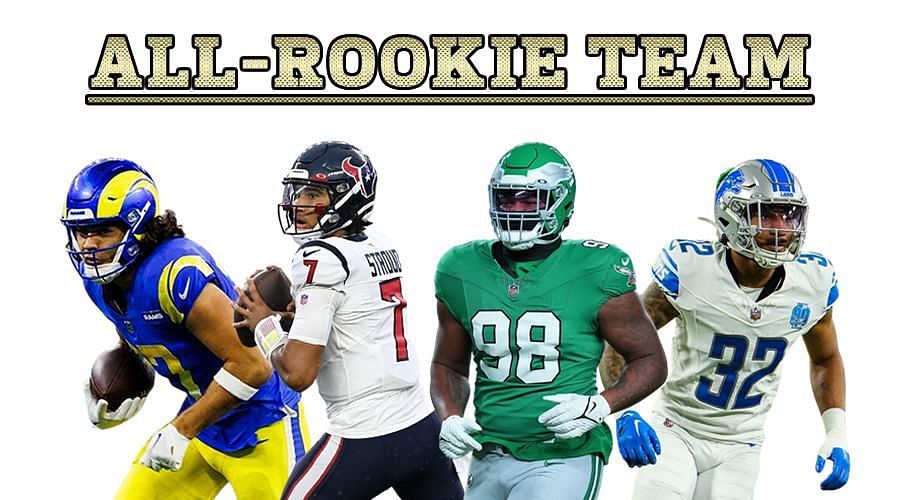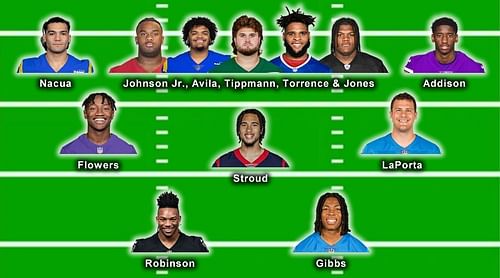
NFL All-Rookie team 2023/24:
The regular season has come to a close and after 17 games, it’s time to talk about what players were able to show in their first years as pros. Therefore, I put together my annual NFL All-Rookie team, consisting of a starting lineup on offense and defense, along with six “key backups”.
Just like the All-Pro teams this year, I decided to add a 12th spot to offense and defense, along with the classic four special-teamers. However, I took a little more freedom with that, since only two rookie fullbacks saw extended run (Cowboys’ Hunter Luepke and Saints’ Adam Prentice) and I thought there were more deserving players along the defensive front than an additional slot defender since I already went with nickel personnel.
Let’s get into it:
Offense:

QB C.J. Stroud, Texans
RB Bijan Robinson, Falcons
FLEX Jahmyr Gibbs, Lions
WR Puka Nacua, Rams
WR Zay Flowers, Ravens
WR Jordan Addison, Vikings
TE Sam LaPorta, Lions
LT Paris Johnson Jr., Cardinals
LG Steve Avila, Rams
C Joe Tippman, Jets
RG O’Cyrus Torrence, Bills
RT Broderick Jones, Steelers
It’s rare that one rookie quarterback stands this far above the rest, especially considering all four guys drafted inside the top-40 started at least four games and three others did so as well. However, while the Colts’ Anthony Richardson was off to a dazzling start, Stroud never really looked like a rookie all season long.
He missed two games due to a concussion, but among quarterbacks who started at least half the season, he ended up leading the NFL with 273.9 passing yards per game, he finished third with 66 completions of 20+ yards and posted 26 total touchdowns compared to only five interceptions.
More importantly, he and offensive coordinator Bobby Slowik turned an offense that finished dead-last between 2021 and ’22 combined in EPA per play into a slightly above-average unit, with a top-10 mark in dropback EPA. Stroud led three game-winning drives and the Texans went from a three-win squad to a 10-win division champ.
For my flex spot, I went with the second running back drafted within the top 12, pairing up Bijan Robinson with Jahmyr Gibbs. I put the former in the more traditional running back slot, since Gibbs was brought along slower, although he improved throughout the season as his touches started to pile up.
Bijan was locked into an offense that disappointed with their usage of their top-end skill-position talent (which ultimately got their head coach fired), but you could feel – and see in the numbers – the downgrade every time some other back for Atlanta got the ball. Still, he was able to rack up 1463 yards and eight touchdowns from scrimmage, averaging 4.6 yards per carry and 8.4 yards per catch. Meanwhile, Gibbs with 38 less touches (234), still put up 1261 scrimmage yards and reached the end-zone 11 times.
His receiving total could easily be higher, if Detroit utilized him more down the field in that regard, but unlike popular belief, he was able to show – especially in David Montgomery’s absence – how effective a decision-maker and runner he is between the tackles, averaging 5.1 yards per carry, with 2.3 of those coming AFTER contact.
Of course, De’Von Achane is a really strong alternate, setting a league-record with 7.8(!) yards per carry, just under total 1000 yards and 11 TDs. And it really hurt me to not even be able to put the Titans’ Tyjae Spears on as a key backup (152 touches, 838 yards and three TDs).
As for the four pass-catchers listed, Nacua obviously highlights the group, after setting new rookie records in catches (105) and receiving yards (1468), with six touchdowns scored and nearly another 100 yards on the ground, as Sean McVay’s new version of Robert Woods. You saw him take a lot of those fly sweeps, be a valuable asset as insert-blocker in the run game and pick apart zone coverage when Cooper Kupp was out.
However, he also showcased the ability to line up outside and win one-on-ones with consistency. With that being said, in no way should this take away from the spectacular debut campaign Sam LaPorta had. He finished top-five among all tight-ends in catches (86) and yards (889), while leading the position with ten touchdowns.
The Lions targeted him on some shot plays and he broke a tackle more than every ten receptions, but most importantly he’s been a chain-mover, with 58 combined first downs and TDs (first among TEs). For the two other WR slots, I went with the latter two of four consecutive names selected in first round. Flowers was used on quite designated touches, particularly in the screen game, which explains his average depth of target of just 8.4 yards.
Yet, he was able to average more than five yards after the catch, he converted 59.7% of catches into first downs or touchdowns and he had four grabs for 40+ yards, plus a 37-yard rushing TD. Addison was deployed more traditionally, being brought along slowly initially but then stepping up in the absence of Justin Jefferson. On 108 targets, he hauled in 70 of those for 911 yards and ten TDs, including 15 plays of 20+ yards, and while Vikings QBs became a little too aggressive chucking it to him at times, he only dropped three opportunities.
As we transition to the offensive line, I had a tough time settling on a tackle duo, since you could absolutely argue for the Bears’ Darnell Wright here, but while Paris Johnson Jr. and Broderick Jones both started at right tackle for their respective NFL teams as well, they excelled on the blindside in college and in particular the first of those two was cross-trained – and performed better at LT – during his time at Ohio State.
Pro Football Focus did charge him with eight sacks, but that was on 1060 total snaps for a team that was largely trailing and he was only penalized six times for 60 yards. Meanwhile, Jones barely played in five of the first seven games, but across basically 12 starts, he was charged with exactly half as many sacks, penalties and yards as his counterpart.
Moving on to guard, I had to flip over O’Cyrus Torrence to the right side – where he dominated at Louisiana and Florida – as his presence was clearly felt for a Bills team that relied less on Josh Allen’s legs, yet was tied for the NFL’s second-highest rushing success rate (45.7%) and had their first 1000-yard rusher since 2017. Torrence also allowed them to maintain pocket integrity more regularly and gave up just two sacks.
Avila was a pro-ready lineman himself coming out of TCU, which is indicated by just two sacks and penalties responsible for (15 yards) each. Him working double-teams with his fellow linemen in a more vertically-oriented run scheme was key to Kyren Williams’ league-leading 95.3 yards on the ground per game.
As for the center spot, there were far less attractive options, but I ultimately settled on Tippman, who had some bright moments for an otherwise heavily struggling Jets front-five. Across just over 800 snaps, he was charged with three sacks and just 30 yards off penalties (eight flags thrown).
Key backups: QB Aidan O'Connell (Raiders), RB De'Von Achance (Dolphins), WR Rashee Rice (Chiefs), TE Dalton Kincaid (Bills), OT Darnell Wright (Bears) & IOL Sidy Sow (Patriots)